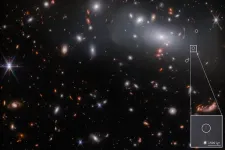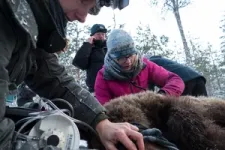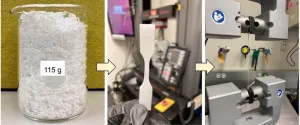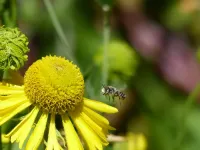(Press-News.org) Using first-of-their-kind observations from the James Webb Space Telescope, a University of Minnesota Twin Cities-led team looked more than 13 billion years into the past to discover a unique, minuscule galaxy that generated new stars at an extremely high rate for its size. The galaxy is one of the smallest ever discovered at this distance—around 500 million years after the Big Bang—and could help astronomers learn more about galaxies that were present shortly after the Universe came into existence.
The paper is published in Science, one of the world's top peer-reviewed academic journals.
The University of Minnesota researchers were one of the first teams to study a distant galaxy using the James Webb Space Telescope, and their findings will be among the first ever published.
“This galaxy is far beyond the reach of all telescopes except the James Webb, and these first-of-their-kind observations of the distant galaxy are spectacular,” said Patrick Kelly, senior author of the paper and an assistant professor in the University of Minnesota School of Physics and Astronomy. “Here, we’re able to see most of the way back to the Big Bang, and we've never looked at galaxies when the universe was this young in this level of detail. The galaxy’s volume is roughly a millionth of the Milky Way’s, but we can see that it’s still forming the same numbers of stars each year.”
The James Webb telescope can observe a wide enough field to image an entire galaxy cluster at once. The researchers were able to find and study this new, tiny galaxy because of a phenomenon called gravitational lensing—where mass, such as that in a galaxy or galaxy cluster, bends and magnifies light. A galaxy cluster lens caused this small background galaxy to appear 20 times brighter than it would if the cluster were not magnifying its light.
The researchers then used spectroscopy to measure how far away the galaxy was, in addition to some of its physical and chemical properties. Studying galaxies that were present when the Universe was this much younger can help scientists get closer to answering a huge question in astronomy regarding how the Universe became reionized.
“The galaxies that existed when the Universe was in its infancy are very different from what we see in the nearby Universe now,” explained Hayley Williams, first author on the paper and a Ph.D. student at the Minnesota Institute for Astrophysics. “This discovery can help us learn more about the characteristics of those first galaxies, how they differ from nearby galaxies, and how the earlier galaxies formed.”
The James Webb telescope can collect about 10 times as much light as the Hubble Space Telescope and is much more sensitive at redder, longer wavelengths in the infrared spectrum. This allows scientists to access an entirely new window of data, the researchers said.
“The James Webb Space Telescope has this amazing capability to see extremely far into the universe,” Williams said. “This is one of the most exciting things about this paper. We're seeing things that previous telescopes would have ever been able to capture. It’s basically getting a snapshot of our universe in the first 500 million years of its life.”
The research was supported by the National Science Foundation and NASA through the Space Telescope Science Institute, with additional funding from the United States-Israel Binational Science Foundation and the Spanish State Research Agency.
In addition to Williams and Kelly, the research team included University of Minnesota School of Physics and Astronomy postdoctoral researcher Wenlei Chen, Professor Claudia Scarlata, Ph.D. student Yu-Heng Lin, and graduate student Noah Rogers; University of Copenhagen researchers Gabriel Brammer, Jens Hjorth, and Danial Langeroodi; Ben-Gurion University of the Negev Associate Professor Adi Zitrin; University of California Los Angeles faculty member Tomasso Treu; Space Telescope Science Institute researchers Anton Koekemoer, Lou Strolger, and Justin Pierel; Chiba University faculty member Masamune Oguri; University of Cantebria researcher Jose Diego; Astronomical Observatory of Trieste researcher Mario Nonino; University of the Basque Country Professor Tom Broadhurst; University of La Laguna researchers Ismael Perez-Fournon and Frederick Poidevin; University of California Santa Cruz Assistant Professor Ryan Foley; Rutgers University Professor Saurabh Jha; University of California Berkeley Professor Alexei Filippenko; and University of Tokyo postdoctoral researcher Lilan Yang.
END
Researchers discover tiny galaxy with big star power using James Webb telescope
Galaxy is the smallest ever discovered at this distance—around 500 million years after the Big Bang
2023-04-13
ELSE PRESS RELEASES FROM THIS DATE:
Humans, and piglets, and bears, oh my! Preventing dangerous blood clots
2023-04-13
“Don’t poke the bear”, they said. But that’s exactly what a team of scientists have been doing, to discover the secrets of blood clotting.
Hibernating bears, paralysed humans, and pigs kept in small enclosures all avoid dangerous blood clots, despite being immobile for extremely long periods.
Research from the University of Reading, with partners in Denmark, Germany, Norway and Sweden, shows that reduction of a key protein prevents the formation of blood clots in all three mammal species when they ...
UTSA astrophysicist leads international team in discovery of new exoplanet outside Earth’s solar system
2023-04-13
(SAN ANTONIO) April 13, 2023 - An international research team led by UTSA Associate Professor of Astrophysics Thayne Currie has made a breakthrough in accelerating the search for new planets.
In a paper slated for publication April 14 in Science, Currie reports the first exoplanet jointly discovered through direct imaging and precision astrometry, a new indirect method that identifies a planet by measuring the position of the star it orbits. Data from the Subaru Telescope in Hawai`i and space telescopes from the European Space Agency (ESA) were integral to the team’s discovery.
An ...
Shift to ‘flash droughts’ as climate warms
2023-04-13
Embargoed: Not for Release Until 19:00 (7.00 pm) British Summer Time, Thursday, 13 April 2023
Shift to ‘flash droughts’ as climate warms
‘Flash droughts’ have become more frequent due to human-caused climate change and this trend is predicted to accelerate in a warmer future, according to research published today [13 April 2023] involving the University of Southampton.
The research published in Science shows that flash droughts, which start and develop rapidly, are becoming ‘the new normal’ for droughts, making forecasting and preparing for their impact more difficult.
Flash ...
First Nations populations at greater risk of severe flu, research finds
2023-04-13
First Nations populations at greater risk of severe flu, research finds
Responsible for over 5 million infections and 100,000 deaths every year, influenza remains one of the most challenging public health issues for populations globally, particularly First Nations communities.
New research from the Peter Doherty Institute for Infection and Immunity (Doherty Institute) has found that First Nations populations around the world are significantly more likely to be hospitalised and die from influenza compared to non-Indigenous populations.
Researchers from the Doherty ...
Channeling mechanical energy in a preferred direction
2023-04-13
A research group led by scientists from the RIKEN Center for Emergent Matter Science have developed a unique material, based on nanofillers embedded in a hydrogel, that can channel mechanical energy in one direction but not the other, acting in a “nonreciprocal” way. With this composite material--which can be constructed at various sizes--the team was able to use vibrational up-and-down movements to make liquid droplets rise within a material against gravity. Using this material could thus make it possible to make use of random vibrations and move matter in a preferred direction.
Channeling energy in a preferred direction is an ...
Chemists redesign biological PHAs, ‘dream’ biodegradable plastics
2023-04-13
They’ve been called “dream” plastics: polyhydroxyalkanoates, or PHAs. Already the basis of a fledgling industry, they’re a class of polymers naturally created by living microorganisms, or synthetically produced from biorenewable feedstocks. They’re biodegradable in the ambient environment, including oceans and soil.
But there’s a reason PHAs haven’t taken off as a sustainable, environmentally benign alternative to traditional plastics. Crystalline PHAs are brittle, so not as durable and convenient as conventional plastics. They cannot easily be melt-processed and recycled, making them expensive to produce.
Colorado State ...
Bees flock to clearcut areas but numbers decline as forest canopy regrows, OSU research shows
2023-04-13
CORVALLIS, Ore. – Native bees in the Oregon Coast Range are diverse and abundant in clearcut areas within a few years of timber harvest but their numbers drop sharply as planted trees grow and the forest canopy closes, research by Oregon State University shows.
The findings are important for understanding the roles forest management might play in the conservation of a crucial pollinator group, the researchers said.
The study, led by graduate student Rachel Zitomer and Jim Rivers, an animal ecologist in the OSU College of Forestry, was published in Ecological Applications.
“The research demonstrates ...
Global study finds some women experience heavier menstrual flow after COVID-19 vaccination
2023-04-13
A new international study finds that women vaccinated for COVID-19 have a slightly higher risk for a heavier period after vaccination.
The study, led by Oregon Health & Science University reproductive health services researcher Blair Darney, Ph.D., M.P.H., and physician-scientist Alison Edelman, M.D., M.P.H., published today in the British Journal of Obstetrics and Gynaecology. These findings build on prior work from the same research team that first identified an association between COVID-19 vaccines ...
Virtual fitting rooms can be a double-edged sword
2023-04-13
AMES, IA – Driven by online shopping, a growing number of retailers have launched virtual fitting rooms in recent years. That includes Amazon, the top apparel seller in the U.S., along with Nike, Macy’s and Walmart. The virtual rooms allow shoppers to ‘try on’ clothes through interactive simulation technology and texture-mapped product images. It can cut down on returns and nudge hesitant shoppers to click the checkout button.
But findings from a recently published study indicate virtual fitting rooms could backfire on retailers if they assume ...
Low-professionalism residents later draw higher patient complaints: Study
2023-04-13
The first study to examine evaluation scores for professionalism and interpersonal communication skills among physicians-in-training and what happens afterward as these doctors begin their practice is reported in JAMA Network Open. The study tracked 9,340 early-career physicians from across the country.
The study finds a strong association between lower ratings for these competencies among residents in their last year of training and greater likelihood of unsolicited patient complaints among doctors during their first year of employment ...
LAST 30 PRESS RELEASES:
Sleeping in on weekends may help boost teens’ mental health
Study: Teens use cellphones for an hour a day at school
After more than two years of war, Palestinian children are hungry, denied education and “like the living dead”
The untold story of life with Prader-Willi syndrome - according to the siblings who live it
How the parasite that ‘gave up sex’ found more hosts – and why its victory won’t last
When is it time to jump? The boiling frog problem of AI use in physics education
Twitter data reveals partisan divide in understanding why pollen season's getting worse
AI is quick but risky for updating old software
Revolutionizing biosecurity: new multi-omics framework to transform invasive species management
From ancient herb to modern medicine: new review unveils the multi-targeted healing potential of Borago officinalis
Building a global scientific community: Biological Diversity Journal announces dual recruitment of Editorial Board and Youth Editorial Board members
Microbes that break down antibiotics help protect ecosystems under drug pollution
Smart biochar that remembers pollutants offers a new way to clean water and recycle biomass
Rice genes matter more than domestication in shaping plant microbiomes
Ticking time bomb: Some farmers report as many as 70 tick encounters over a 6-month period
Turning garden and crop waste into plastics
Scientists discover ‘platypus galaxies’ in the early universe
Seeing thyroid cancer in a new light: when AI meets label-free imaging in the operating room
Neutrophil-to-lymphocyte ratio may aid risk stratification in depressive disorder
2026 Seismological Society of America Annual Meeting
AI-powered ECG analysis offers promising path for early detection of chronic obstructive pulmonary disease, says Mount Sinai researchers
GIMM uncovers flaws in lab-grown heart cells and paves the way for improved treatments
Cracking the evolutionary code of sleep
Medications could help the aging brain cope with surgery, memory impairment
Back pain linked to worse sleep years later in men over 65, according to study
CDC urges ‘shared decision-making’ on some childhood vaccines; many unclear about what that means
New research finds that an ‘equal treatment’ approach to economic opportunity advertising can backfire
Researchers create shape-shifting, self-navigating microparticles
Science army mobilizes to map US soil microbiome
Researchers develop new tools to turn grain crops into biosensors
[Press-News.org] Researchers discover tiny galaxy with big star power using James Webb telescopeGalaxy is the smallest ever discovered at this distance—around 500 million years after the Big Bang








